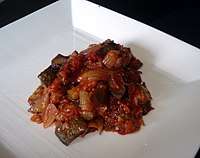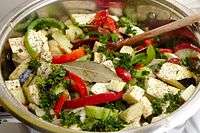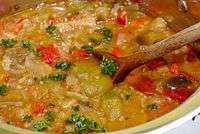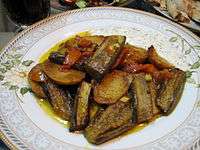Ratatouille
Ratatouille (/ˌrætəˈtuːi/ RAT-ə-TOO-ee, French: [ʁatatuj]; Occitan: ratatolha [ʀataˈtuʎɔ]) is a French Provençal stewed vegetable dish, originating in Nice, and sometimes referred to as ratatouille niçoise (French: [niswaz]).[1] Recipes and cooking times differ widely, but common ingredients include tomato, garlic, onion, courgette (zucchini), aubergine (eggplant), bell pepper, and some combination of leafy green herbs common to the region.
| Alternative names | Ratatouille niçoise |
|---|---|
| Type | Stew |
| Course | Main |
| Place of origin | France |
| Region or state | Provence-Alpes-Côte d'Azur |
| Main ingredients | Vegetables, (tomatoes, onions, courgette, aubergine (eggplant), bell peppers), garlic, marjoram, fennel and basil or bay leaves and thyme |
| Variations | Confit byaldi |
Origins
The word ratatouille derives from the Occitan ratatolha[2] and is related to the French ratouiller and tatouiller, expressive forms of the verb touiller, meaning "to stir up".[3][4] From the late 18th century, in French, it merely indicated a coarse stew. The modern ratatouille – tomatoes as a foundation for sautéed garlic, onion, zucchini, aubergine (eggplant), bell pepper, marjoram, fennel and basil, or bay leaf and thyme, or a mix of green herbs like herbes de Provence – does not appear in print until c. 1930.[5]
Preparation
The Guardian's food and drink writer, Felicity Cloake, wrote in 2016 that, considering ratatouille's relative recent origins (it first appeared in 1877), there exists a great variety of methods of preparation for it.[6] The Larousse Gastronomique claims "according to the purists, the different vegetables should be cooked separately, then combined and cooked slowly together until they attain a smooth, creamy consistency", so that (according to the chair of the Larousse's committee Joël Robuchon) "each [vegetable] will taste truly of itself."[7]
 Ratatouille niçoise
Ratatouille niçoise Mixing of ratatouille ingredients in a bowl
Mixing of ratatouille ingredients in a bowl Cooked ratatouille in a pot
Cooked ratatouille in a pot
Related dishes
Similar dishes exist in many cuisines. These include: pisto (Castilian-Manchego, Spain), samfaina (Catalan, Spain), tombet (Majorcan), ciambotta, caponata and peperonata (Italy), briám and tourloú (Greek), şakşuka and türlü (Turkish), ajapsandali (Georgian), lecsó (Hungarian), ghiveci călugăresc (Romanian) and zaalouk (Moroccan). Different parts of the Indian subcontinent have their own versions of winter vegetable stew. Gujarat makes Undhiyu, Kerala Avial, and Bengal Sukto. Confit byaldi is a variation of the dish invented by Michel Guérard.
References
- "Ratatouille". Oxford English Dictionary, 2nd edition (1989)
- « ratatouio », Lou tresor dou Felibrige, Frédéric Mistral
- Alan Davidson (2014). The Oxford Companion to Food. Oxford University Press. p. 655. ISBN 978-0-19-967733-7.
- "Chef Brian Discusses The Origin of Ratatouille Nicoise". LADC. Archived from the original on 2015-10-09.
- Scotto, E., and Marianne Comolli. "Vegetables: A Garden of Eden." France, the Beautiful Cookbook: Authentic Recipes from the Regions of France. San Francisco: Collins, 1989. 195. Print."
- Cloake, Felicity (15 July 2010). "How to make perfect ratatouille". The Guardian. Retrieved 9 September 2016.
- Robuchon, Joël (2008). The Complete Robuchon. New York: Alfred A. Knopf. p. 597. ISBN 978-0-307-26719-1.
External links
| Look up ratatouille in Wiktionary, the free dictionary. |
